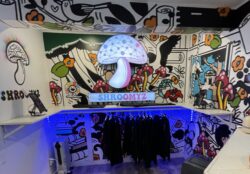A small green label reading “Clean at Sephora” marks dozens of bottles that line the shelves of the store at the Ottawa Rideau Centre. One “clean” product, Bright Illuminating Drops by Drunk Elephant, promises to improve the “clarity and radiance” of skin. Uncertain, Nadia Parhizgar stares as she picks up the product. It’s labeled clean, so she should trust it, right?
“I just stare at the product and think ‘Is this going to be the cure to the years of acne I’ve faced?’” asked Parhizgar. The price — $51.50 for 30 ml — gives her pause. “I work a part-time job at barely over minimum wage, but I see it being advertised to really help clear up your skin, so that’s what will work, right?”
The skincare industry has boomed over the past decade. In Canada, revenues are expected to exceed $2 billion US, and to grow by about two per cent per year until 2028, according to the market analytics firm, Statista. One of the biggest trend-setters in the industry is “clean skincare,” a catch-all for products marketed as natural, organic and/or free of chemicals.
A third of skincare products in the U.S. are now labeled clean and this proportion is expected to grow by 12 per cent by 2027, according to the UK-based market consultancy, Brandessence. Globally, the market for natural skincare products is expected to double from 2021 to 2030, reaching $12.27 billion U.S., according to The Brainy Insights, another market-research consultancy.
Social media influencers have played a big part in the popularity of the trend, heavily promoting clean skincare, and even extending the concept to lifestyles, such as the “clean girl aesthetic,” which features slicked-back buns, glowy skin and athletic leisure wear. As of Jan 20, the #cleanbeauty hashtag had nearly 6.5 million posts on Instagram and 2.1 billion views on TikTok, which also recorded some 500 million views for the term #cleanskincare, and 7.4 million for #cleanbeautyroutine.
The popularity of clean skincare products has soared despite the hefty premium they carry. Fenty Beauty’s clean whipped oil body cream retails for $62.00, for example, while a moisturizer marketed as “clean dewy serum” by the Japanese firm Tatcha sells for $120 for just 30 ml. Natural brightening products, such as Origins’ clean GinZing Into the Glow Brightening Serum, typically sells for $60-70 for 30 ml.
What exactly is “clean skincare”?
There is no legal or scientific definition for terms such as organic, natural, or clean skincare, experts say.
Clean beauty “is ultimately a marketing claim,” said Akemi Ooka, head of global supply chain resources at the Independent Beauty Association.
The definition varies across brands and retailers, Ooka said, adding that the association advises clients to “clearly define the principles upon which their products are built,” to be as transparent as possible.
Sephora provides a definition for its Clean at Sephora products on its website, saying they are “formulated without the ingredients you might like to avoid, such as phthalates, sulfates, parabens and more.” However, the site also highlights that “Sephora does not guarantee that the products are ‘100 per cent free’ from specified ingredients since trace contaminants are possible.”
“It’s a complicated process to determine what these brands really mean when they’re saying they’re organic, clean or natural,” said Dianne Williamson, a professor of cosmetology at Algonquin College.
“It’s a complicated process to determine what these brands really mean when they’re saying they’re organic, clean or natural.”
Dianne Williamson, a professor of cosmetology at Algonquin College
For example, labels such as “organic” don’t make sense, scientifically, she said.
“Anything that is organic … has a chemical compound,” said Williamson. “Even if you’re talking about something like aloe vera, they’re going to have to chemically change it or separate it to get out the ingredient that they actually want.”
The makers of products marketed as “clean” or “all-natural” are taking advantage of consumers’ lack of knowledge of the processes that go into creating skincare products, she said.
“There’s been a fear created that chemicals are bad, that they’re going to ruin your skin. But when you look into it, they’re in everything,” said Williamson. “It’s inevitable to come across them.”
Growing concern about the health impact of chemicals used in cosmetics, such as phthalates and parabens, has been a key driver of the clean skincare trend, observers say. In the case of parabens, a common preservative in many cosmetics, controversy dates back to a 2004 study showing that they appeared in breast tissue, raising concerns about a link to breast cancer. However, this link remains unproven, according to the U.S. Food and Drug Administration.
Preservatives are essential to prevent the growth of harmful bacteria and mold in cosmetics, and many paraben substitutes are highly allergenic, said Jen Novakovich, a Canadian content creator who has a degree in Nutrition and Nutraceutical Sciences from the University of Guelph and now works as a science communicator specializing in cosmetics.
“After extensive testing, parabens seem to be the least allergenic preservative on the market,” said Novakovich. “But … there’s been incredible pressure on the industry to find alternatives. Unfortunately, the alternatives are often more allergenic … which isn’t good news for our emerging skin allergy epidemic.”
Julian Sass, a Montreal-based director of research at the skincare company Matter of Fact, and a skincare-content creator on Instagram, said the growing mistrust of additives is “just making people afraid of things they don’t need to be afraid of, and not taking in the entire body of knowledge that we have on these ingredients into account when making those decisions.”
“You can see that there’s a lot of fear and mistrust on social media when it comes to what people are putting onto their skin,” said Sass, who has a PhD in biomathematics and statistics. “You can really fall into a rabbit hole on social media of ‘Oh everything is a chemical and is going to poison me.’”
He added that many consumers put their trust in social-media influencers rather than scientists.
“There are a lot of influencers who don’t have a degree and are sharing what works for them,” said Sass. “This doesn’t mean it’s going to work for everyone.”
Worse, blind trust in anything labeled clean or natural can lead people to adopt products or practices that can cause harm, critics warn.
Savannah Bain, a 20-year-old student based in Kingston who uses skincare products, said she has seen some influencers promoting potentially harmful practices.
“There are people who have ‘nightly skincare’ routines of them laying 10 or 15 different products on, which is already excessive, but then they make it even worse by layering it on in the wrong order.
“Usually those videos come from people who don’t struggle with acne or sensitive skin,” said Bain, whose interest in skincare dates back to when she developed acne at age 11.
“They’re aesthetically pleasing and usually categorize themselves as some kind of lifestyle, such as a ‘clean girl’ … skincare routine,” she said.
“But [they] aren’t (giving) good advice for the usually young, impressionable people watching them. Nobody needs that many skincare products at one time—especially those with acne.”
Parhizgar, who also has acne, said simple skincare routines work better anyway.
“Through the journey I’ve had, I try to keep it as simple as possible — two to three products a night. I’ve been through the times of using dozens and it’s not effective for me,” she said.
“We see these 12-year-old girls using retinol now. Why are these kids using products meant for aging? Why am I seeing them using products meant for adults?”
Julian Sass, director of research at Matter of Fact and a skincare-content creator
Sass fears for the younger generations being exposed to this type of content. He points to young influencers such as the young teens Harper Zilmer and Evelyn.grwm, both of whom have posted videos of themselves using products with retinol, an anti-wrinkle ingredient.
“We see these 12-year-old girls using retinol now,” he laughed. “Why are these kids using products meant for aging? Why am I seeing them using products meant for adults?”
People who are concerned about what goes into their skincare products need to do their own research, and not just rely on influencers, said Bain.
“I’ve done a lot of research on my own time and learned to rely on (medical) journal articles rather than influencers.”
“I think TikTok is a good jumping off point to see what’s available and I’ve definitely seen someone use a product and gone to search it up myself,” said Bain.
“But I always follow those other steps of looking up the ingredients, reviews, or getting professional opinions. It’s also important to consider why this person is taking their time to talk about this product. Are they getting a sponsorship, reviewing lots of different things for content, or did it genuinely help them?”
Not all influencers are offering questionable advice. Novakovich has an Instagram following of 102,000, which she uses to reach experts and to share her own research with the public.
“I … want to influence the industry to do better by providing all this information. I focus a lot on brand founders, or marketers who really need information” on skincare myths and misinformation, said Novakovich.
She says she and her partner, Michelle Wong, say it is important for them to combat misinformation on social media about skincare products.
“Fear-mongering (about chemicals) is a very popular marketing strategy … that is reaching consumers today,” said Novakovich. “It’s created this vicious cycle of more fear-mongering, (and) more scared consumers, which goes around and around,” she said.
Bain agrees that a lot of misinformation about skincare products is circulating online. More transparency from brands about what goes into their products is essential to help debunk this misinformation, she stressed.
“I think brand transparency is incredibly important because it helps consumers understand what a product does and how it does that. The more transparent a brand is, the more likely I am to trust them, and the more likely I am to buy from them,” said Bain.
“This is especially true for brands that are active in reading and responding to reviews and are open to adjusting their formulations to consumer concerns.”
But Novakovich warned consumers not to believe everything a brand is saying.
“Do your research, talk to people, go see an esthetician,” she advised.




